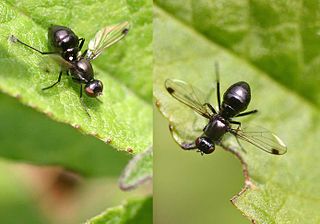
The Sepsidae are a family of flies, commonly called the black scavenger flies or ensign flies. Over 300 species are described worldwide. They are usually found around dung or decaying plant and animal material. Many species resemble ants, having a "waist" and glossy black body. Many Sepsidae have a curious wing-waving habit made more apparent by dark patches at the wing end.

Stalk-eyed flies are insects of the fly family Diopsidae. The family is distinguished from most other flies by most members of the family possessing "eyestalks": projections from the sides of the head with the eyes at the end. Some fly species from other families such as Drosophilidae, Platystomatidae, Richardiidae, and Tephritidae have similar heads, but the unique character of the Diopsidae is that their antennae are located on the stalk, rather than in the middle of the head as in all other flies. Stalked eyes are present in all members of the subfamily Diopsinae, but are absent in the Centrioncinae, which retain unstalked eyes similar to those of other flies. The stalked eyes are usually sexually dimorphic, with eyestalks present but shorter in females.
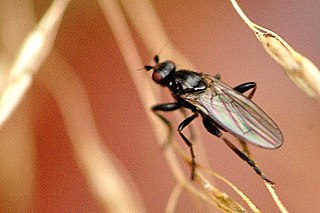
Sphaeroceridae are a family of true flies in the order Diptera, often called small dung flies, lesser dung flies or lesser corpse flies due to their saprophagous habits. They belong to the typical fly suborder Brachycera as can be seen by their short antennae, and more precisely they are members of the section Schizophora. There are over 1,300 species and about 125 genera accepted as valid today, but new taxa are still being described.

Carnoidea is a superfamily of Acalyptratae flies.

The Heleomyzidae is a small family of true flies in the insect order Diptera. Over 740 described species of Heleomyzidae occur in about 76 general distributed throughout the world.

The Lonchaeidae are a family of acalyptrate flies commonly known as lance flies. About 500 described species are placed into 9 genera. These are generally small but robustly built flies with blue-black or metallic bodies. They are found, mainly in wooded areas, throughout the world with the exception of polar regions and New Zealand.
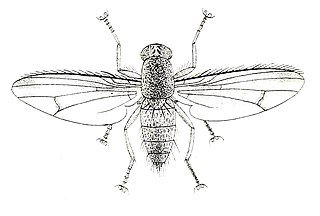
The Curtotonidae or quasimodo flies are a small family of small grey to dark brown humpbacked flies (Diptera) with a worldwide distribution, but with very few species in the Nearctic, Australasian/Oceanian, and Palaearctic regions. Most members of the family are found in tropical to subtropical latitudes in Africa and the Neotropics. Many remain undescribed in collections, since little work on the family has been done since the 1930s.
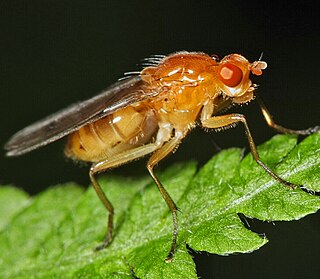
The Dryomyzidae are a small family of flies ranging from 4–18 mm long, with prominent bristles, and yellow to brown or rust-yellow coloring. The wings are very large. The subcosta is complete and well separated from vein 1. Larvae feed on decaying organic matter - carrion, dung, and fungi. The prelambrum protrudes from the oral cavity. Vibrissae are absent and the postvertical bristles are divergent.

Carnidae, also known as bird flies or filth flies, is a family of flies (Diptera). There are 6 genera, containing about 93 species worldwide.

The Coelopidae or kelp flies are a family of Acalyptratae flies, they are sometimes also called seaweed flies, though both terms are used for a number of seashore Diptera. Fewer than 40 species occur worldwide. The family is found in temperate areas, with species occurring in the southern Afrotropical, Holarctic, and Australasian regions.

Diastatidae are a family of flies in the order Diptera. They are encountered primarily in the Holarctic Region, but several species are found in the Oriental, Neotropical and Australasian regions. Members of the family number over 20 described species in three genera. There is an additional fossil genus.

The Tanypezidae, known as the “stretched-foot flies”, are small family of acalyptrate Diptera. The 28 species are found mostly in the New World, divided between two genera: Tanypeza is found in North America, with the type species extending into the Palaearctic, and Neotanypeza is neotropical in distribution and includes one species known only from Dominican amber from 17 to 20 million years ago, N. dominicana Lonsdale & Apigian. This distribution contrasts that of its sister family, the Strongylophthalmyiidae, which is mostly East Asian in distribution.
Syringogaster is a genus of small ant-mimicking flies with a petiolate abdomen, a long prothorax, a swollen and spiny hind femur, and reduced head size and large eyes. There are 20 described extant species and two species known from Miocene amber from the Dominican Republic. It is the only genus in the family Syringogastridae.
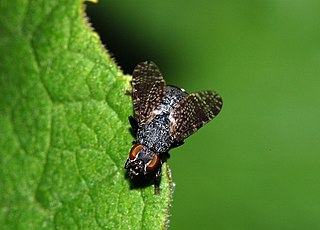
The Platystomatidae are a distinctive family of flies (Diptera) in the superfamily Tephritoidea.
Austroleptis is a genus of snipe flies, and the sole genus in the family Austroleptidae; until 2010, it was placed in the family Rhagionidae. They are small to moderately sized flies of around 3 to 7.7 mm.

The Cryptochetidae are a small family of tiny flies. Some twenty to thirty species are known. Generally they are metallic blue black, stoutly built, with the head broad and high and with clear wings. Like other species in the superfamily Lonchaeoidea, the Cryptochetidae have antennae with a cleft in the second segment. Unlike practically all Schizophora however, they lack an arista, or if they do have one, it is too small to distinguish with any confidence. The family name refers to this unusual distinction; "Cryptochetidae" literally means "those with hidden bristles". The adult flies also are unusual among insects in that they have only a single pair of abdominal spiracles — this is not a serious physiological challenge in such small insects.
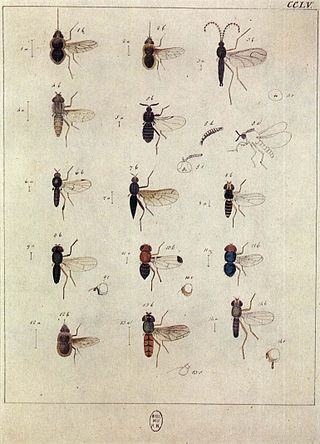
The family Pseudopomyzidae comprises minute to small (1.7–5.5 mm), dark-coloured acalyptrate flies; formerly they have been treated as a subfamily of Cypselosomatidae
Dubius is a genus of flies in the family Dolichopodidae, with seven species distributed in southern China and another five in the Neotropical realm. The genus name is from the Latin word dubius, referring to the variance of frons. The genus was first established by Wei Lian-Meng in 2012, including a group of species from the Neotropical realm previously placed in Chrysotus, as well as five newly described species from China. According to some researchers, all of the Neotropical species should be kept in Chrysotus, as their transfer to Dubius was unwarranted.

Fergusonina, the sole genus in the family of Fergusoninidae, are gall-forming flies. There are about 40 species in the genus, all of them producing galls on Eucalyptus, Melaleuca, Corymbia, and Metrosideros species in Australia and New Zealand.
Somatia is the sole genus of the acalyptrate brachyceran fly family Somatiidae. The genus includes about seven Neotropical species of small black and yellow flies with a stout and rounded thorax having transverse suture. The legs are separated from the main body by an elongated post-coxal bridge. The broad abdomen is downcurved. The antenna are elbowed with the arista bipectinate. Somatiids resemble members of the Syringogastridae due to the enlarged pronotum and a postcoxal bridge but they have a petiolate abdomen.















